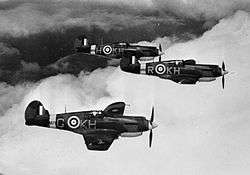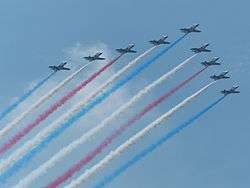Vic formation

The Vic formation is a formation devised for military aircraft and first used during World War I. It comprises three or sometimes more aircraft flying in close formation with the leader at the apex and the rest of the flight en echelon to left and right, the whole resembling the letter "V". The name is derived from the term for the letter V in the phonetic alphabet of the time. It is still in use today, though it has been superseded or replaced in some circumstances.
History
At the start of the First World War little thought had been given to the most efficient formations to use for military aircraft. Groups of fliers (drawn from the various nations Army or Navy) would fly in columns, or line ahead, as if they were troops of cavalry or flotillas of ships. This was soon found to be inefficient, for several reasons. First, the leaders were unable to communicate with their squadrons, and they with him, other than the vague instruction to follow the leader. Second, if they came under anti-aircraft fire from the ground, the flight would either all turn at once, scattering the formation, or they would follow the leader round a point, as horsemen or ships, maintaining cohesion but being exposed to fire on a fixed point. The remedy was to fly in a close V formation, allowing the aircraft to make a sudden 180 degree turn if fired upon, which would leave them flying out of danger with the formation intact, though with their positions in the formation reversed.[1]
The formation also allowed the fliers to see each other and communicate by hand signals; it also allowed them to stay together in poor visibility or cloud. Later, when bomber and reconnaissance flights came under attack from fighter aircraft, the Vic proved to have good defensive characteristics; pilots, looking inwards to maintain formation could overlook each other for attackers, while their observer/rear gunners could use interlocking fire to protect each other.
The Vic was the basic flying formation adopted by every major air force; the French Air Force referred to it as the Chevron, while to the Germans it was the Kette. It remained the standard formation throughout the inter-war years and into World War II.
The basic unit was the three plane section, in a Vic; two sections made up a flight, and two flights a squadron. Squadrons would fly in line astern, one Vic behind another, leaving the squadron leader effectively the only person looking for the enemy.

At the outbreak of the Second World War the Vic was still in use by both bombers and fighter formations in most air forces; however the German air forces fighter units had changed to the more flexible and aggressive pair (Rotte) and four (Schwarm) combination. These comprised a pair (leader and wingman) and four (two pairs) in a “finger-four” arrangement
Luftwaffe pilots were disparaging about the RAF’s use of the Vic formation during the Battle of Britain, calling them Idiotenreihen (“rows of idiots”)[2] though in practice there was little else Allied pilots could do. Germany, as the aggressor, had the choice of how and when to attack, and, based on their experience during the Spanish Civil War, had changed and developed their tactics accordingly. Fighter Command could only make do until the battle was over before reviewing and making changes.
Bob Oxspring, a Pilot Officer in 66 Sqdn, and a future ace, commented:
"We knew there was a lot wrong with our tactics during the Battle of Britain but it was one hell of a time to alter everything we had practiced.
We had not time to experiment when we were in combat three and four times a day. Moreover we were getting fresh pilots straight out of Flying School who were trained –barely- to use the old type of close formation- they simply could not have coped with anything radically different."[3]
In addition, the primary purpose of Fighter Command was to intercept the bombers, who still flew in the defensive Kette; therefore the optimum formation for attacking them was a corresponding three plane Vic, so each fighter would find itself against a different bomber. [4]
This was also the conclusion of the Luftwaffe later, when faced with USAAF bombers in their box formations of massed Vics, German pilots reverted to the Kette to tackle them.[5]
Some modifications were made by the RAF within the Vic structure; Pilots learned to open the formation, and the rear-most Vic in a Squadron was tasked with weaving, to improve observation, but casualties amongst the weavers remained high.
When the campaign was over Fighter Command experimented with, and adopted, the pair and four arrangement, though these might fly in echelon or in line astern, to aid identification. Douglas Bader, of 242 Sqdn experimented with the finger four arrangement and found it beneficial; by 1941 it was in general use in the RAF.[6]
1942 saw the arrival of the U.S. Army Air Forces, with its strategy of daylight bombing; tight bomber formations relying on massed defensive fire were expected to win through to the target. The most basic formation for bombers was a three-plane "V" called an "element". Stacks of these elements were configured to form a defensive bombing formation called the "combat box". These combat boxes, involving full squadrons, groups or entire wings, could produce huge fire-power and offer mutual support, though casualties were and remained high without fighter escort.

The Vic formation remains in use today.
Notes
References
- Michael Burns: Bader: The Man and his Men (1990) ISBN 0 304 35052 4
- Norman Franks: Dog-Fight: Aerial Tactics of the Aces of World War I (2003) ISBN 1-85367-551-2
- Tony Holmes: Spitfire vs Bf 109 (2007) ISBN 978 1 84603 190 8
- Alfred Price: Blitz on Britain 1939-1945 (1977) ISBN (none)
- Mike Spick: Luftwaffe Fighter Aces (1996) ISBN 1 85367 560 1